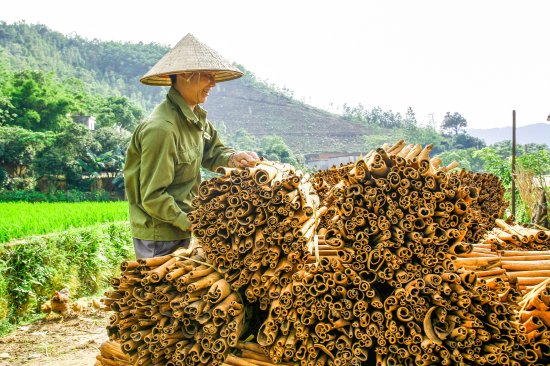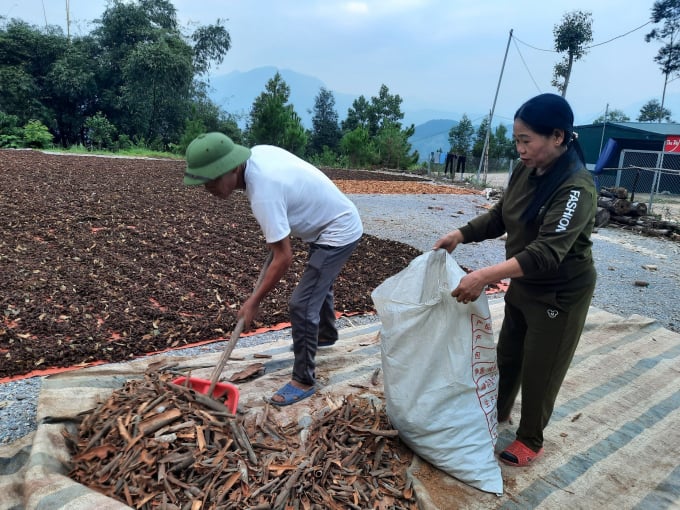November 22, 2025 | 16:01 GMT +7
November 22, 2025 | 16:01 GMT +7
Hotline: 0913.378.918
November 22, 2025 | 16:01 GMT +7
Hotline: 0913.378.918
Cinnamon is a woody, perennial tree that can grow up to 15m tall. Cinnamon planted after 10 years can be peeled for the first time. The whole trunk, branches, roots and leaves of the cinnamon tree can be used to make essential oil or as medicine and spice. This tree is suitable for the climate and soil in the eastern districts of Quang Ninh province such as Binh Lieu, Dam Ha, and Tien Yen.

People in Binh Lieu district (Quang Ninh) harvest cinnamon.
According to the calculation of experts, the total economic value of 1 ha of 15-years-old cinnamon is estimated at VND 600 million. The average profit people gain from growing cinnamon is estimated at VND 40 million/ha/year, over two times higher than other trees.
Although the price of cinnamon is now higher compared to previous years, due to the influence of the weather, the cinnamon tree is slow to peel the bark, plus a lot of rain greatly affects the harvest.
In order to improve the economic value of cinnamon growers, over the years the People's Committee of Binh Lieu district has directed specialized departments and communes to encourage people to actively invest, expand the area, and improve the quality of cinnamon. The district has implemented a plan to support the planting and development of forest products, aiming to turn cinnamon into an OCOP product (One Commune One Product).
Cinnamon is a tree with many uses, thus having high economic value. But to further increase the value of cinnamon products, it is required to have a long-term plan, methodical investment and the participation of potential businesses.
Quang Ninh currently has over 3,400 ha of cinnamon growing land, mainly concentrated in the districts of Dam Ha (4,500ha), Tien Yen (900ha), Binh Lieu (700ha) and scattering in Ba Che and Hai Ha districts. Meeting the strict demands of the EU, Quang Ninh's organic cinnamon products have been certified and qualified for export to this market.

Cinnamon has brought stable income to the people of Quang Ninh. Photo: Nguyen Thanh.
Each ha of cinnamon grown for 15-20 years yields 12-17 tons of cinnamon bark, with the selling price ranging from VND 27,000 to 29,000/kg for fresh cinnamon bark type I, and VND 18,000 to 20,000/kg for shredded cinnamon bark.
To fully unlock the potential of cinnamon, Quang Ninh People's Committee has also directed the Department of Agriculture and Rural Development to issue a document on the development of the cinnamon organic material area. Quang Ninh Agricultural Extension Center is assigned to coordinate with Son Ha Spices Co., Ltd. to work, survey, train personnel, prepare documents, and take samples in localities with concentrated cinnamon growing areas such as Dam Ha, Tien Yen, and Binh Lieu.
According to statistics, 330 ha of cinnamon of 79 households within the province’s territory has been certified to meet the EU organic standards. Cinnamon products were purchased and exported to the European market by Son Ha Spices and Flavors Co., Ltd. right in the April 2021 cinnamon crop. Organic cinnamon in Quang Ninh is expected to reach an output of 600 tons in 2022 and will be fully exported.
A representative of Son Ha Spices Co., Ltd. said that Quang Ninh's cinnamon quality met export demands of the EU market thanks to its Couramin active ingredient index ranging from 595 to 893 ppm, meeting its standard of lower than 3,500 ppm. This is the advantage that Quang Ninh cinnamon has compared to other provinces because other cinnamon products in Lao Cai and Yen Bai provinces have an index ranging from 3,630 to 7,903 ppm.
Quang Ninh plans to build an additional 150-200 ha of concentrated cinnamon growing area in Dam Ha, Tien Yen and Ba Che districts to serve export demand. And in the near future Quang Ninh Department of Agriculture and Rural Development will organize training courses on science and technology for cinnamon growing households. Through training courses growers can exchange and grasp techniques of planting, caring, and harvesting cinnamon to improve productivity and product quality.
Translated by Samuel Pham

(VAN) The information was shared at the seminar 'Urban Agriculture - Solutions for Developing Green Spaces,' organized by the Kinh te & Do thi Newspaper and the Biotechnology Center of Ho Chi Minh City.
/2025/11/19/4141-2-132831_216.jpg)
(VAN) One of Japfa's outstanding solutions is implementing digital transformation and artificial intelligence (AI) to optimize operations, enhance productivity, and advance sustainable development.
/2025/11/19/4847-1-093540_448.jpg)
(VAN) The Gia Lai Provincial People’s Committee had a working session with the delegation of the U.S. Department of Agriculture, the State of Idaho, and representatives of the State's leading enterprises.

(VAN) Ca Mau has a sufficient foundation to become a strong regional aquaculture center, where production integrates the economy, the environment, and the lives of the people.

(VAN) SEIKI Group envisions itself as a pioneer in the ‘dual transformation’ of digital technology and green industry, standing alongside the Government and Vietnamese businesses in their pursuit of sustainable development.

(VAN) The VNGEONET network affirms Viet Nam's progress in mastering digital space, providing a precise positioning data platform to serve socioeconomic development.
/2025/11/14/3247-1-184556_35.jpg)
(VAN) Thai Nguyen is methodically implementing digital transformation in the livestock sector, laying the foundation for a modern, transparent, and sustainable agriculture.